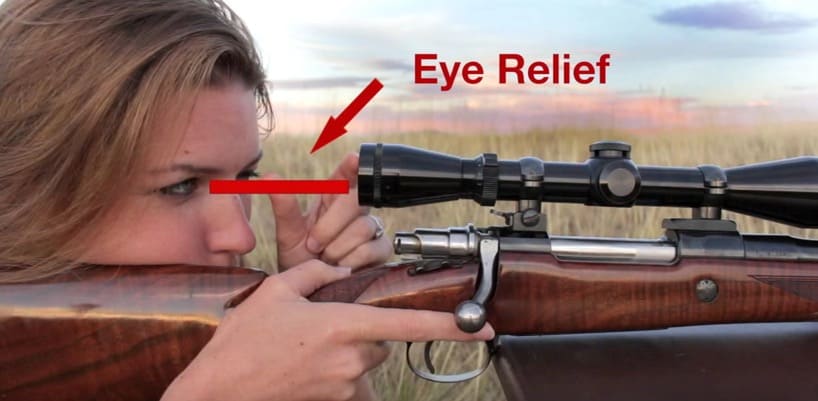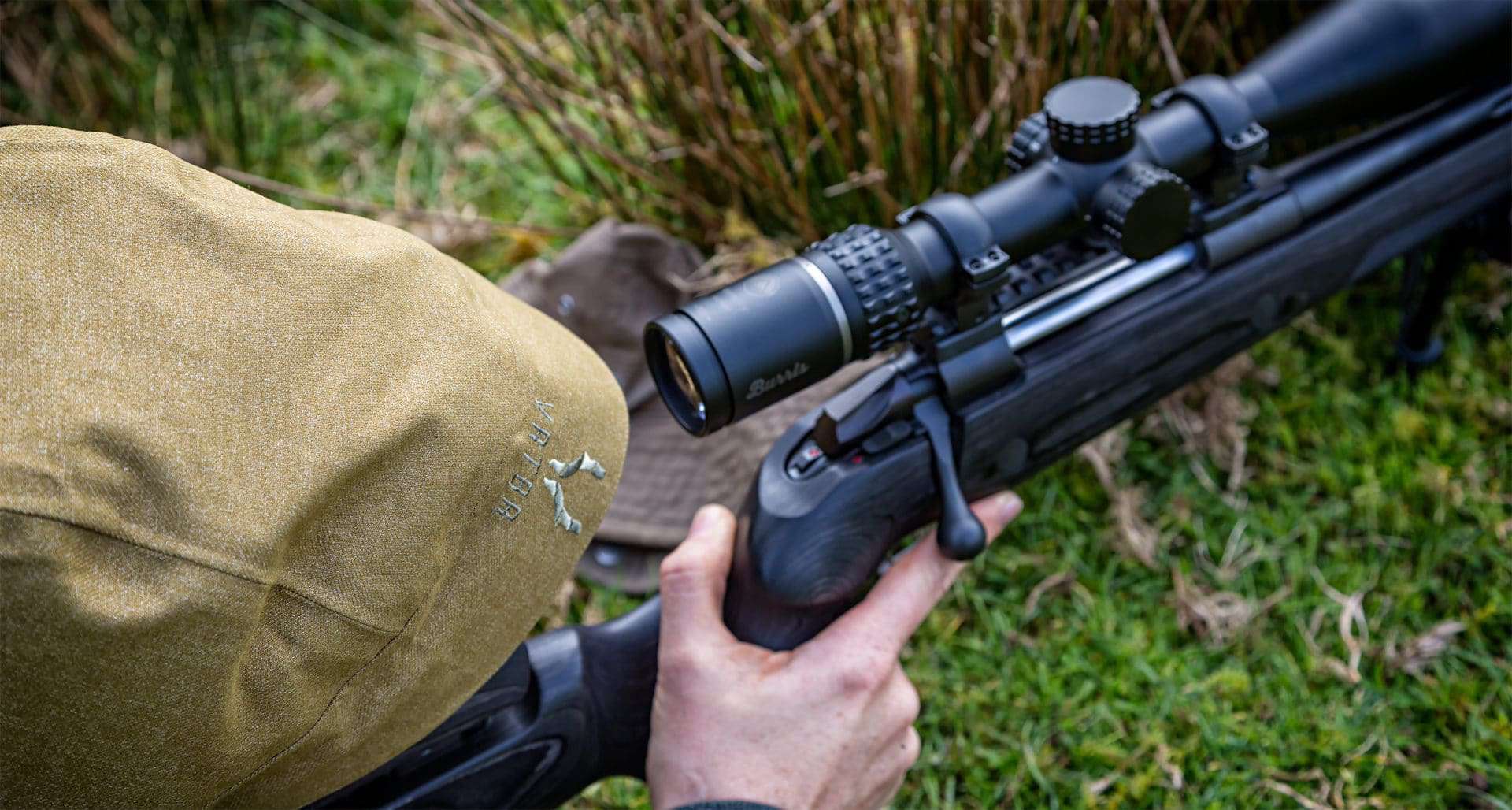The importance of eye relief in scopes is tantamount to your physical (and mental) health. We’re sure that you want hunting to be a long term endeavor, so it’s best to sit back, relax, bandage your wounds, read this article and get back into the game with a more intelligent perspective!
To start off, let’s define eye relief. To not complicate things with unnecessary sentences, eye relief is the distance between your eyes and the ocular lens of your scope. Unless you’re a lunatic, you’re more than invited to keep your eye relief at least three to four inches wide, to avoid any injury.
There is a caveat, however, the more distant your eyes, the less you see on the scope, that’s how science, unfortunately, works baby! If you stumble upon the term ‘exit pupil’, you’ll know what it means: The line of eyesight available to you at a certain eye relief distance!
Put in simpler terms, it is the circle of light you see whilst holding your rifle.
Now that we know what eye relief is, let’s get down to the nitty-gritty of its use, importance, light transmission, stratification, determination and possible changes in the future of eye relief in scopes.

Use
Eye relief varies from scope to scope and must be determined individually. If you fail to do so, you not only risk injury, but the image being projected will either be fuzzy around the edges or you’ll only see a small array of the entire image.
The most popular rifle scope used in hunting is the ol’ 3×9. Depending on your magnification, the eye relief changes laterally with it.
In a 3×9 scope, your eye relief will be a lot wider while you’re zooming in at 3x rather than at 6x and so on.
The more you zoom in (magnify), the shorter your eye relief will generally be.
What one first has to determine when installing a scope on to his rifle is the natural position of the rifle while in shooting mode. This prevents wrong measurements of eye relief and lets you determine the optimal magnification as well as eye relief when the scope finally comes on.
That’s why you should never share your rifle with anyone else and it is recommended that every hunter has its own rifle while in the hunt for some game.
Importance
If you don’t want to get smacked around like a little wuss by your own rifle, you better make sure that your eye relief is matching. Not only that, but as already mentioned, if you falsely determine your eye relief, the picture reflected in your eyes will not match reality and you’ll most likely miss your shot.
Incidentally, having a permanent scope bite isn’t a mark of heroism or adventurousness, just a sign of poor planning and not having done the due diligence necessary for the task at hand.
Light Transmission
What many pundits in the hunting game don’t realize is that scopes don’t actually gather light, rather they transmit it. The level of light transmission directly correlates to the quality (and price, unfortunately) of the scope.
Most scopes hover in the 90% range, really great scopes reach up to 95% and professional scopes are championing it at 97-98%.
What does this have to do with eye relief?
Everything, as more lightning, especially during dusk or at night time, means a better line of sight. It also allows for more tinkering when it comes to eye relief, i.e. you can adjust it to better suit you rather than the circumstances you’re left with.
Stratification
Here’s where things get a bit murky, but we’ll try to keep it as simple as possible.
In the past, it was quite easy to simply go into a shop, expect the industry standard of 3,5 inches of eye relief and simply outright buy the rifle and go hunting.
With the industry growing and hunting becoming a popularized hobby, there are more and more rifles, as well as scopes being produced and all of this has an effect on eye relief, as it is determined differently by each individual rifle.
With that being the case, the old industry standard simply doesn’t measure up to all the new hosts of rifles being introduced.
In our professional opinion, we see it as necessary to increase the industry standard of eye relief to at least five inches. Such a move would alleviate many of the third brows we’re bound to stumble upon in these days.
With that in mind, let’s look at the main stratification when it comes to eye relief in scope.
Short Eye Relief
Anything less than 0,5 inches is considered to be short eye relief. The scope is almost pocking your eye socket in such cases.
Some hunters consider anything below 5 inches to be short eye relief, but we’ll leave that up for interpretation as only you, as an individual, can determine what short or long eye relief is for you.
Most people don’t experience any problems with short eye relief but special note goes to those wearing glasses or any other equipment that alters their field of view. They have problems with short eye relief and should consider opting for a larger option.
To those people that have eye problems yet still for some reason want a rifle scope with short eye relief, I recommend to try and test it out, just don’t blame us if you catch your glasses flying!
We do have to mention that short eye relief has its benefits, those being a brilliant level of magnification options, a more useful reticle (works especially well at longer ranges), better balance as the scope is closer to your body and finally, a clear picture of what is transpiring in front of the hunter.
Long Eye Relief
Long eye relief is usually preferable for larger weapons, such as rifles, but they can also be used on handguns.
Generally speaking, when rifles are concerned, anything beyond 4,5 inches is considered to be long eye relief.
In most cases, this is the preferable eye relief and it should be taken as a median when it comes to rifle scopes.
You just have to ensure that your eye is always in the perfect line of eye relief, something which often gets forgotten by those preferring long eye relief. Otherwise, you’ll experience a loss in clarity of your sight and the amount of light transmitted will be significantly lower, which might cause you to misjudge your next shot.
These are the benefits of long eye relief in scopes: Perfect for handguns or larger rifles with low magnification, better for larger cartridges, rapid loading of your weapon, easy to mount scopes.
Determining Eye Relief
We’re not going to become ophthalmologists, but we do have to analyze the eye a bit as if we were one.
Depending on your age, the average eye dilates by up to 5mm when light is shone onto it. Younger folk boast up to 8mm while older people must find themselves satisfied with 4mm or sometimes even lower.
This difference becomes especially noticeable when there’s little light around.
The biggest caveat hunters have is the sort of ‘halo’ that appears when there’s not enough light there.
That is why it’s important to know your limitations (as said, depending on your age) and proceed accordingly.
To determine the perfect eye relief for your scope and your eyes, your best bet is testing it out yourself.
You should aim for a clear and concise image, without any halos or blurry lines on the fringes of the image appearing in front of you.
Changes in Community Standards
There’s a wind of change in the minds of many companies trying to peddle big rifles and other guns with high recoil, such as handguns.
While the community standard always hovered around 3,5 inches of eye relief, many are now adopting the mantra of 5 inches being the more suitable option.
We are glad to see such a positive trend as not only the precision of the hunters themselves will increase but also the possible damages of operating a high recoil weapon without adequate eye relief will decrease.
If anyone tries to peddle a large rifle or a handgun with less than 5 inches of eye relief, you give them the bird and find another shop, as they are clearly not looking out for their customers or they are simply careless and aren’t up with the times.
Conclusion
We’ve covered everything there is to cover when it comes to eye relief in scopes. It’s a very important topic that is oftentimes overlooked not just by newbies just joining in the game but by hobbyists and pundits as well.
This leads to much unnecessary suffering and injuries sustained that could have been prevented had one done the research beforehand.
Be that as it may, now you’re equipped with the crucial knowledge about eye relief in scopes and now you can go out there and have fun without the fear of being punched by your own rifle.
Happy hunting!
Mike Fellon is an experienced firearms enthusiast and optics expert. He delivers unbiased and detailed rifle scope reviews. Born and raised in Dallas, Texas. He inherited his hunting passions after his father John – he was fascinated by his stories, hearing how much attention, focus, dedication and patience he invested in shooting every animal. When he was old enough, his father first allowed him to shoot some cans and bottles with his shotgun, and then took him hunting – it was love at first sight. Mike has never stopped shooting ever since.

